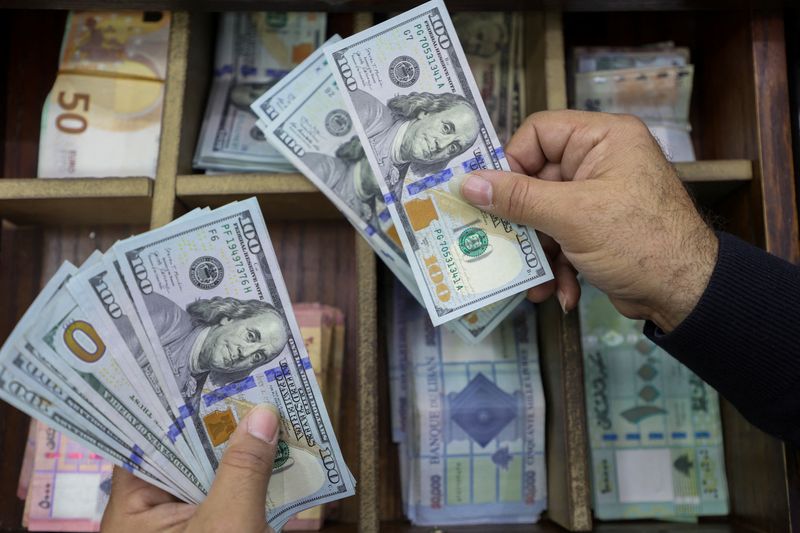Forex
US dollar share of global FX reserves stays flat in Q2 -IMF


© Reuters. A money exchange vendor holds U.S. dollar banknotes at his shop in Beirut, Lebanon December 21, 2022. REUTERS/Mohamed Azakir
By Gertrude Chavez-Dreyfuss
NEW YORK (Reuters) -The U.S. dollar’s share of global currency reserves reported to the International Monetary Fund was 58.9% in the second quarter, unchanged from the first three months of the year, IMF data showed on Friday.
Claims in U.S. dollars rose 0.8% to $6.576 trillion in the second quarter, but were down 1% from a year earlier.
The euro’s share edged up slightly to 19.9% in the second quarter, from 19.8% the previous three months. Euro claims grew 1% in the quarter and increased 2% from a year earlier.
“The dollar is still the dominant currency in foreign exchange and international funding. Its share of over-the-counter FX transactions has remained remarkably stable,” wrote Michael Langham, emerging markets analyst at abrdn, in one of his latest pieces on the future of the U.S. currency’s influence.
But he pointed out the greenback’s share of currency reserves has been on a “gradual downward trend,” falling over 10 percentage points over the past 20 years. Much of this shift, he said, has been driven by a rotation into other developed market currencies, such as the euro, British pound, the Canadian dollar and Australian dollars.
The Chinese has also snagged a share of the reserves, but from a very low base, he added.
That said, Langham noted there is a high bar for risks on the dollar to threaten its dominance.
Global reserves, which are reported in U.S. dollars, are central bank assets held in different currencies used in part to support their liabilities. Central banks sometimes use reserves to help support their respective currencies.
The was up 3.1% in the second quarter, recovering from a 0.9% fall in the first quarter. In the fourth quarter of 2022, the dollar index dropped 7.7%.
The euro, on the other hand, slid 3.1% in the quarter after rising 1.2% in the first three months of the year. It surged 9.3% in the last three months of 2022.
The IMF data also showed the Chinese renminbi’s share of currency reserves slipped to 2.4% in the second quarter from about 2.6% in the first. A year ago, that share was 2.8%. In absolute terms, central bank holdings of the yuan fell nearly 5% to $274.10 billion. The IMF started tracking the yuan’s share since 2017.
The Japanese yen’s share was steady at 5.4% in the latest quarter from about 5.5% in the first three months of 2023. In dollar terms, yen reserves fell 1.2% to $602.86 billion.
IMF data also showed total global reserves rose to $12.055 trillion in the second quarter from $12.028 trillion in the first quarter. In the fourth quarter of 2021 reserves hit a record $12.92 trillion.

 Forex3 years ago
Forex3 years agoForex Today: the dollar is gaining strength amid gloomy sentiment at the start of the Fed’s week

 Forex3 years ago
Forex3 years agoUnbiased review of Pocket Option broker

 Forex3 years ago
Forex3 years agoDollar to pound sterling exchange rate today: Pound plummeted to its lowest since 1985

 Forex3 years ago
Forex3 years agoHow is the Australian dollar doing today?

 Cryptocurrency3 years ago
Cryptocurrency3 years agoWhat happened in the crypto market – current events today

 World3 years ago
World3 years agoWhy are modern video games an art form?

 Commodities3 years ago
Commodities3 years agoCopper continues to fall in price on expectations of lower demand in China

 Economy3 years ago
Economy3 years agoCrude oil tankers double in price due to EU anti-Russian sanctions





























